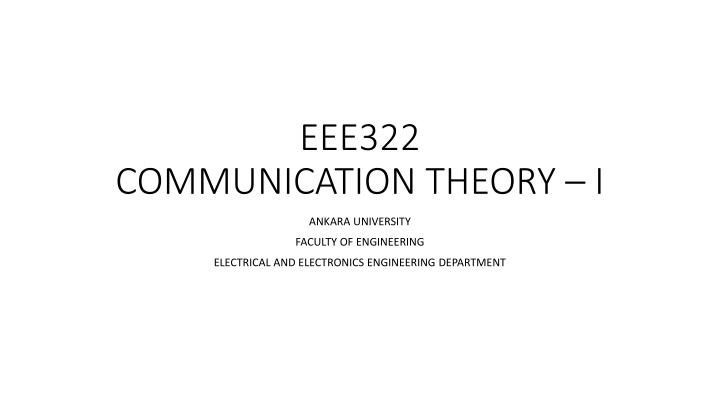
Communication Theory I: Understanding Amplitude Modulation at Ankara University
Explore the concepts of amplitude modulation in Communication Theory I at Ankara University, specifically focusing on double-sideband modulation, carrier signals, spectra analysis, and signal extraction methods. Gain insights into AM signals and spectra, including Fourier transformations and the characteristics of AM spectrum components. Dive into the world of electrical and electronics engineering through practical applications and theoretical foundations.
Download Presentation

Please find below an Image/Link to download the presentation.
The content on the website is provided AS IS for your information and personal use only. It may not be sold, licensed, or shared on other websites without obtaining consent from the author. If you encounter any issues during the download, it is possible that the publisher has removed the file from their server.
You are allowed to download the files provided on this website for personal or commercial use, subject to the condition that they are used lawfully. All files are the property of their respective owners.
The content on the website is provided AS IS for your information and personal use only. It may not be sold, licensed, or shared on other websites without obtaining consent from the author.
E N D
Presentation Transcript
EEE322 COMMUNICATION THEORY I ANKARA UNIVERSITY FACULTY OF ENGINEERING ELECTRICAL AND ELECTRONICS ENGINEERING DEPARTMENT
EEE322 COMMUNICATION THEORY - I LECTURE 5 CONTINUOUS WAVE MODULATION: AMPLITUDE MODULATION Ankara University, Electrical and Electronics Engineering Department, EEE322 Communication Theory I
AMPLITUDE MODULATION There are two types of double-sideband amplitude modulation: standard amplitude modulation (AM) suppressed-carrier double-sideband modulation (DSB). Ankara University, Electrical and Electronics Engineering Department, EEE322 Communication Theory I
AMPLITUDE MODULATION AM Signals and Spectra: If ??denotes the unmodulated carrier amplitude, modulation by x(t) produces the AM signal ??? = ??1 + ?? ? ?????? = ???????? + ???? ??????? where ? is a positive constant called the modulation index. Ankara University, Electrical and Electronics Engineering Department, EEE322 Communication Theory I
AMPLITUDE MODULATION AM Signals and Spectra: The signal s envelope is then ? ? = ??[1 + ?? ? ] Figure 4.2 1(Carlson, page 175) shows part of a typical message and the resulting AM signal with two values of . Ankara University, Electrical and Electronics Engineering Department, EEE322 Communication Theory I
AMPLITUDE MODULATION AM Signals and Spectra: The envelope clearly reproduces the shape of x(t) if ?? ? and ? 1 When these conditions are satisfied, the message ?(?) is easily extracted from ??(?) by use of a simple envelope detector. Ankara University, Electrical and Electronics Engineering Department, EEE322 Communication Theory I
AMPLITUDE MODULATION AM Signals and Spectra: Going to the frequency domain, Fourier transformation of the signal s envelope yields ??? =1 2??? ? ?? +? 2??? ? ??? > 0 Ankara University, Electrical and Electronics Engineering Department, EEE322 Communication Theory I
AMPLITUDE MODULATION AM Signals and Spectra: The AM spectrum consists of carrier-frequency impulses and symmetrical side bands centered at ??. The presence of upper sidebands and lower sidebands accounts for the name double-sideband amplitude modulation. Ankara University, Electrical and Electronics Engineering Department, EEE322 Communication Theory I
References Communication Systems, An Introduction to Signal and Noise in Electrical Communication, 5th edition, A.B. Carlson, P.B. Crilly, J.C. Rutledge, Mc Graw Hill. An Introduction to Analog and Digital Communications, 2nd edition, S. Haykin, M. Moher, Wiley. Ankara University, Electrical and Electronics Engineering Department, EEE322 Communication Theory I
